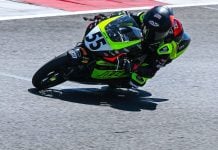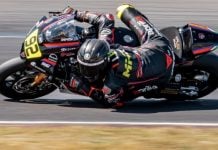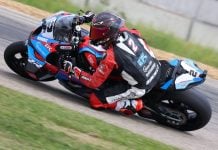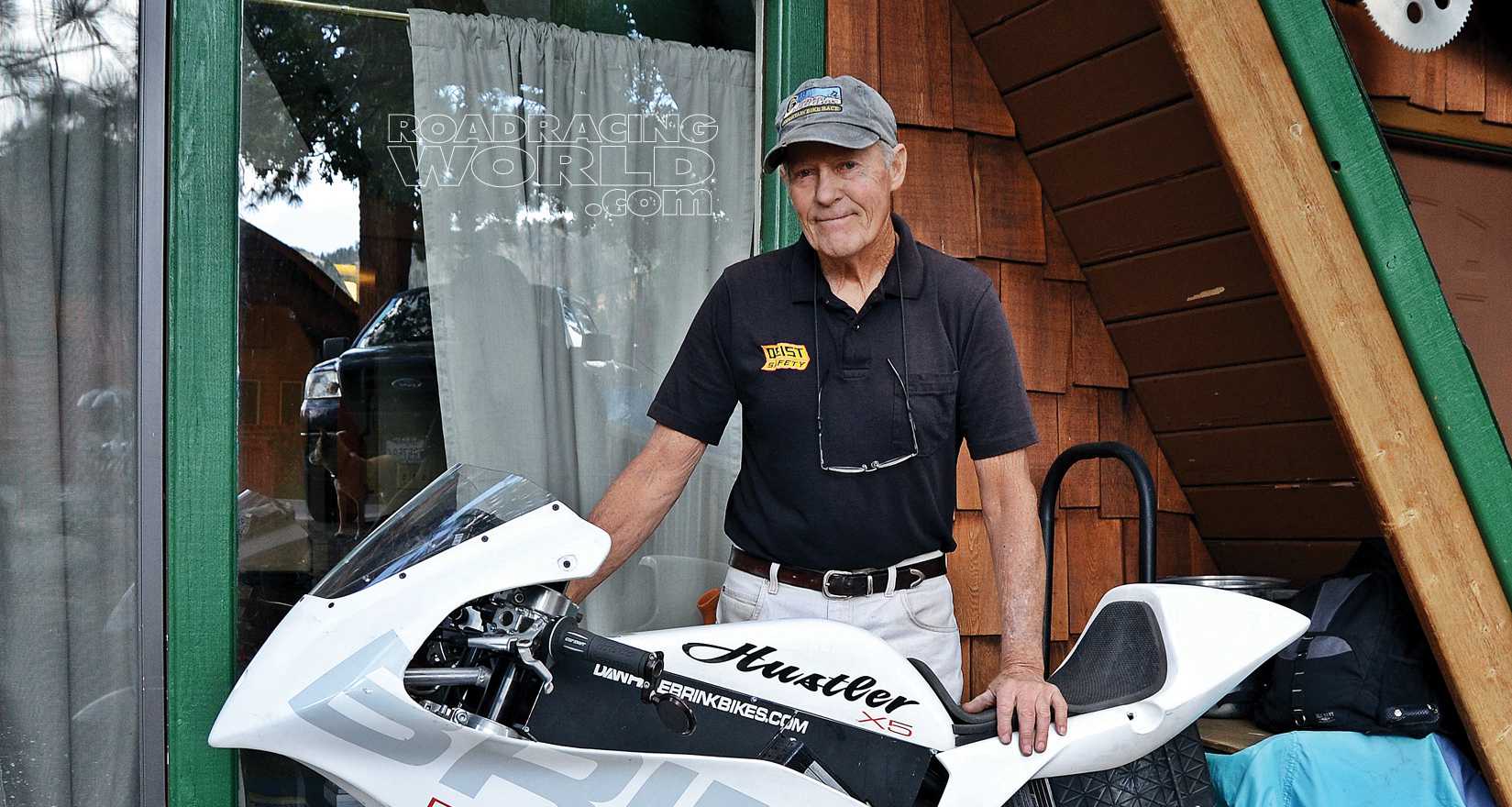The following article was originally published in the December 2014 issue of Roadracing World & Motorcycle Technology magazine. To subscribe, click on the Subscribe tab on the home page.
Copyright 2014-2019, Roadracing World Publishing, Inc.
PROFILE: Inventor/Racer Dan Hanebrink
“I Don’t Do Things The Way Other People Do …”
By Michael Gougis
Most people who wanted to race an open-class production-based motorcycle in the early to mid-1970s chose between a Kawasaki four-cylinder DOHC Z1 900 or three-cylinder H2 two-stroke 750, a Honda four-cylinder SOHC CB750 or a Yamaha R5 350 two-stroke. If they wanted to race a limited production, purpose-built racebike, they could buy a Yamaha two-cylinder two-stroke 250 or 350 or later a four-cylinder two-stroke TZ700 or TZ750.
Then there is Dan Hanebrink, who built himself a monocoque racebike fitted with air/oil springless suspension, powered by a three-cylinder, two-stroke 750cc snowmobile engine with belt drive and a continuously variable transmission (CVT).
“I don’t do things the way other people do,” says Hanebrink, age 75, a pioneer in off-road bicycling and still pushing the performance envelope, now on the electric motorcycle frontier. “As I’ve been developing the bike and the batteries and the electronics, I’ve been working on performance.”

(Above) The “Monotrack” monocoque racebike without bodywork. Note three expansion chamber stingers, without mufflers. Photo courtesy Dan Hanebrink.
Hanebrink’s latest project is the Hustler X5, an electric motorcycle based on the idea that a smaller, lighter machine—about the size of a 250cc GP racebike—would make an excellent zero-emissions motorcycle.
The Hustler is designed to reach 130 mph, offer a range of more than 100 miles at a more sane speed before recharging, and attract motorcyclists interested in a performance electric bike who are willing to pay nearly $30,000 for one.
“You can go really fast for a short period of time, or you can turn down the power and go further,” Hanebrink says. “The range will be 100-150 miles, depending on power use, in an economical mode.”
It’s not surprising to find Hanebrink innovating on the edge of a new technology that promises to revolutionize every vehicle on the planet. Look through Hanebrink’s past, and he’s worked on rocket-ships, built revolutionary cars, made board-tracker replicas, designed mountain bikes that needed parachutes to slow down—the list goes on.
And Hanebrink is still creating madly. His base is an A-frame mountain cabin, crammed with streamliners, electric bikes designed for golf course use, the occasional road racer, mountain bikes hanging from the ceiling, and—of course—a machine shop in the basement where his creations come to life.
***
Back in the 1960s, Hanebrink moved to Southern California to attend the Art Center College of Design and study automotive design. He had an interest in vehicles, but had no desire to move to Detroit to work on cars there. So Hanebrink started working contract jobs in Southern California, engineering everything from farm equipment to Apollo rockets. The contracts were short-term, one month to six months at a pop. But they gave him a broad range of experience and the willingness to work on nearly anything that came along.
Hanebrink also served in the Marines, in the reserves during the Vietnam conflict. Interestingly, he learned to write for publications—newspapers, magazines—from the Corps’ public relations department. When he got out, he supplemented his engineering work with articles, photos and drawings of vehicles that he sold to car and bike magazines in Southern California.
But Hanebrink always was designing things, and was itching to build his own vehicles. One of the first was called “The Box.” It was designed with Matt Van Leeuwen, and it was a box-section four-wheeler made from a fiberglass/balsa wood composite and powered by a Kawasaki two-stroke engine. The initial version was steered with your feet—something that likely was quite interesting at the vehicle’s triple-digit top speed. Hanebrink sold eight of the vehicles in kit form, and learned a painful lesson. “I never kept one, because I couldn’t afford to keep one,” he says. “I try to keep one of everything I design now.”
Hanging around the motorcycle media at the time sparked Hanebrink’s interest in road racing motorcycles. Not one to mess around with easily available stuff, Hanebrink’s first road racing bike was a Honda CR93 originally purchased in Okinawa, he says. His was the equivalent of a satellite factory racebike, he says, with a five-speed transmission. What he remembers most is that it was slightly slower than the two-strokes that were coming to the fore, and that he had to pre-heat the oil on a stove before pouring it into the engine prior to starting, as recommended by the factory.

(Above) Dan Hanebrink (202) and his three-cylinder 750cc snowmobile-powered “Monotrack” road racer on the 3.76-mile road course at Ontario Motor Speedway, circa 1976. Photo by John Ulrich.
When that bike eventually blew up, Hanebrink threw his lot in with the two-strokes, building kits for Kawasaki Triples. But eventually building kits wasn’t enough. He raced at Southern California tracks like Ontario Motor Speedway, Riverside International Raceway, Orange County International Raceway (a dragstrip/return-road course) and Willow Springs International Raceway.
He would show up with a monster—the Monotrack. This machine now sits in his crowded kitchen—because, you know, where else do you display a one-of-a-kind road racer? The spec chart is impressive and terrifying all at once. It started life with a 650cc, three-cylinder, two-stroke snowmobile engine. Hanebrink punched it out to 750cc. It powered the rear wheel (which Hanebrink made) via belt drive and a continuously variable transmission. The chassis was a magnesium monocoque. Hanebrink also built the springless suspension, which used oil to compress air in a remote reservoir. His favorite track was Willow Springs International Raceway, he says. Now, take a deep breath and imagine driving that thing off into Turn Eight at Willow with the throttle at the stop …
Hanebrink won a WERA Open GP race at Willow Springs on the machine, he says, but his favorite memory of riding it was at Ontario Motor Speedway. He snuck up on accomplished racers Keith Code and Rudy Galindo in practice, he explains, mugged them in the infield and smoked them on the banking. And sneaking up on someone on this thing was no small accomplishment, he says.
“People said it was the loudest motorcycle they’d ever heard,” Hanebrink remembers. “And because of the variable transmission, it didn’t sound like the other bikes. Other riders would complain all the time, ‘the sound of that thing is (messing) with my head!’ It was a challenge to get right. But when it was right, people would come up to you and tell you how good it was—that’s the payoff right there.”
Eventually, Hanebrink says he grew weary of the expense of road racing, and the danger. One day, he simply turned away from the sport, bought a Maico motocross machine and went racing at Saddleback Park, a now-defunct off-road facility in Irvine, California. He enjoyed the lower-key atmosphere, the lower costs and lower risks. Somewhere in here, he built a streamliner for a road race run on closed, public roads in Mexico; built magnesium wheels for a speedway racer—you get the idea.
Meanwhile, Hanebrink had moved to the mountains above San Bernardino, into a quiet little town called Big Bear Lake, a mile and a half in the sky. One day, someone came by his home with an off-road bicycle. This started a whole new series of adventures. Hanebrink made complete bikes; built forks that became as ubiquitous on race-winning bicycles as Öhlins forks are on MotoGP machines today; and got into off-road bicycling and downhill bike racing himself. He put himself on a fitness program that paid dividends; meet him today, and you wouldn’t come close to guessing his age, based on his looks.
Long story short, when the high-end off-road bicycle market collapsed, he got back into motorcycles, building street customs. When that market collapsed, he turned his attention to the electric bike market, and did well there with long-travel, fat-tired specials that sold for $8,000 to $12,000 or more.
His off-road machines are unique, designed to traverse rough terrain that would repulse a normally-tired bike. He’s also designed unique electric bikes for very specific applications, such as moving golfers across a course without causing damage to the delicate turf.

(Above) Monotrack racebike’s air/oil suspension uses a reservoir mounted behind each fork leg.
A silent electric drive allows Hanebrink’s machines to be used where a bike powered by an internal combustion engine can’t be used. Hanebrink just sold an off-road electric bike to a high-end dog trainer who is using it to replace his horse while training dogs in rough terrain.
But Hanebrink is a racer, and the pursuit of performance defines his history. It is not surprising that his latest creation is a performance machine, and it is equally unsurprising that he is pushing his suppliers to give him more power.
***

(Above) Dan Hanebrink poses with his Hustler X5 electric prototype, featuring a monocoque chassis, small wheels and bodywork off a Honda RS125.
From a pure powertrain point of view, there’s not a lot new on the Hustler X5. The drive train is based on his well-proven off-road machines, and power is transmitted through a three-speed derailleur chain drive system to the rear wheel. The lithium-ion batteries are liquid-cooled. It’s industry standard hardware, but Hanebrink has spent years developing his particular configuration to meet a variety of needs. “My electronics are made in the U.S. and Great Britain. But it’s pretty much the same stuff as everyone else has,” he says.
Where Hanebrink breaks from tradition is in the chassis. “What everyone else has done is take a twin-spar frame and build battery racks inside that frame. Essentially, they are standard chassis with batteries and an electric motor,” Hanebrink says. “I did not start with a regular bike. I started with my own concepts. This one is a full-blown aluminum monocoque. The frame is a box which contains the batteries and the electric motor and the majority of the electronics.
“I wanted a smaller bike, about the size of a road racing 250cc GP bike. I’m using 14-inch wheels—and there’s a great Bridgestone tire available for that size. That tire has a great profile—it’s like one that you’d see on a sportbike.”
From that starting point, Hanebrink’s machines are a blend of racebike engineering and unique thinking. An aluminum swingarm doesn’t raise any eyebrows, but the carbon-fiber bodywork does. The 14-inch wheel size certainly looks unique. The weight—about 195 to 220 pounds, depending on configuration—is definitely unique in the world of performance machines available for the street. With a wheelbase of 52 inches, Hanebrink says the small size and lack of weight of the machine accounts for a lot of its performance.
The machine features a single disc brake in the front, rear suspension by Race Tech and inverted forks by a company from China called Fast Ace, Hanebrink says. The front and rear brake calipers on the production bike will be Brembo. The test mule still uses a Hanebrink-built rear wheel, but that will be replaced with a 14-inch wheel on the production models. The triple clamps are amazing. The forks actually rotate in large ball bearing sockets where they pass through the triple clamps, and the steering stem can quickly be moved forward or backward to adjust the steering geometry.

(Above) Hustler electric motorcycle’s triple clamps allow quick geometry changes—note alignment marks to the right of the steering stem. After the steering stem nut is loosened, the steering stem can be moved forward or rearward by turning the bolt seen protruding below the upper clamp in this photo.
The whole thing feels race-bike-small, but not toy-like. The seating position reminds one of a large 125cc GP machine, or a 250cc GP bike with less room between the seat and pegs. The test mule is finished with Honda RS125 bodywork.
“A lot of the parts on this thing are parts that I already make,” Hanebrink says. “I was amazed at how light it turned out. It’s the weight of a good racebike. It’s kind of a long bike, compared to a Moto3 machine. It’s not a minibike. It’s designed to fit a regular person.”
***
The Hustler X5 is an extension of the work he’s done on his off-road machines. But given his racing background, Hanebrink isn’t starting from scratch. He knows what he wants his machine to do, and is equally aware of his business model and his target customer. The bikes are built on custom order, and a deposit is required before the build starts. Hanebrink is currently building his first production Hustler X5 for a customer who plunked down a deposit on the $29,000 machine.
What the customer gets is something utterly unique in the world of performance motorcycling. And that has been Hanebrink’s business philosophy for a long time now—make something unique and functional, and the right customers will find a way to your door.
“You don’t need to sell a lot, but you need to get a decent price for the ones you do sell,” Hanebrink says. “I didn’t want to go toe-to-toe with the big boys in the electric bike market. And I know that the really big boys—Honda and Yamaha—are coming. I wanted to find a niche. I don’t want to follow other people.” RW






